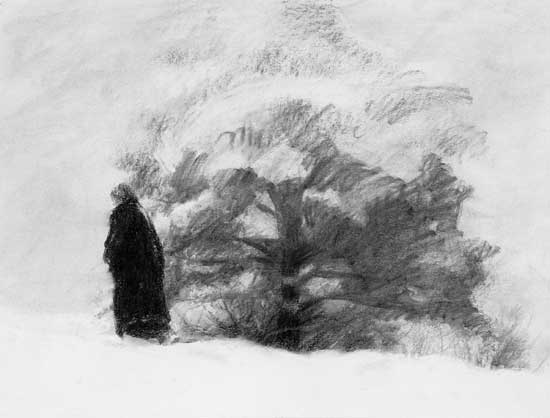Enjoy this free step by step charcoal drawing tutorial by artist Dan Scultz.
Step by Step Charcoal Drawing Tutorial
For this drawing I used vine charcoal and compressed charcoal on Strathmore 400 series 80 lb. drawing paper.
[adinserter block=”34″]

Step 1:
I decided to start this drawing by toning the sky area with vine charcoal and a chamois cloth to achieve a soft look but still have some interesting marks. By starting with the sky I can work from the background to the foreground and not have to draw the sky “around” the foreground objects later in the drawing.

Step 2:
I tend to look for my biggest shapes to start my block-in and begin measuring to get the shapes correct. In this case, I started with the tree first since it is the largest object in the composition.

Step 3:
[adinserter block=”34″]
Using the measurements of the tree, I can accurately place my focal point (the figure). I make sure to spend as much time as necessary getting the measurements correct so I can avoid having to make major drawing adjustments as I continue through the drawing. I also look at my drawing in the mirror to further check for any drawing errors. It’s definitely easiest to make corrections in this early stage.

Step 4:
I try to develop my focal point early because it will set the value range for the rest of the drawing. My darkest areas will be in the figure and I intend to make the other elements secondary by keeping their values a little lighter in comparison. I’m using compressed charcoal for these darkest darks in order to get a dark enough value. I’m also thinking about edges in this stage since sharper edges will help direct the viewer’s eye to the figure and then throughout the piece.

Step 5:
The figure is now mostly finished so I move on to the tree but am careful to keep comparing values and edges to my focal point so I can keep it predominant. Again, I check the drawing in the mirror to see if anything is distracting from the focal point.

Step 6:
As I near completion, I continue developing the tree and also start adding the foreground snow. I keep the foreground simple enough so that it will lead the viewer into the scene without competing with the other elements in the drawing.
[adinserter block=”34″]

Step 7:
One last look at the drawing in the mirror helps me see if there is anything else that I need to adjust. If not, then I’m finished!
I hope you enjoyed this charcoal drawing tutorial. Find more charcoal drawing lessons on our site here.
Artist’s Statement

Visual art is a language — a means of communication. As an artist, I realize that something is communicated through my work each time it is viewed whether it’s what I want to communicate, or something entirely different that is brought to the experience by the viewer. But as I communicate using this visual language through images of people, images of landscapes, and sometimes images that combine the two, I hope to relate to others the beauty of God’s creation and that through it, I believe he communicates with us. I feel that it is my responsibility to help remind others of the importance of visual art and that it can be admired, embraced, enjoyed and understood.
My interest in making artwork that portrays people stems from my intrigue with people’s ability to create connections between each other. I have long enjoyed creating images of people whether it be a portrait, a child or a woman in a tranquil landscape. I believe that people can easily relate on a personal level to images of other people. And it seems like everyone can relate to an image of a landscape that reminds them of a favorite place. When I work outdoors — standing at my easel with the landscape laid out before me — I feel a connection to the scene that I’m painting. And each time, I feel like I see more beauty in the world than I did the time before.
In order to capture these connections and relate them to the viewer, I often choose a color scheme that is simple and harmonious, which makes my paintings sometimes appear to have one overall dominant color. This allows me to express my connection with each work of art I create, and allows the viewer to experience a direct connection back to the me as the artist. I also experience this connection while viewing favorite works by other artists. They transport me to another world — one of exciting color, texture and emotion that can lift my spirit and renew my passion as an artist. I believe that you too can liberate your senses through the wonder of art and discover that it speaks to you. It only takes a few moments to begin to understand the language, and as you learn, it will become even more meaningful.
Visit Dan’s site to view more of his work and to learn more about him:
Sign Up For Dan’s Email Newsletter
Every month or so, Dan sends out announcements about new artwork, upcoming shows and other news. If you would like to receive these announcements please take a moment to sign up for his newsletter by following the link below:
I’m amazed, I have to admit. Seldom do I encounter a blog that’s equally educative and
interesting, and let me tell you, you’ve hit the nail on the head. The issue is something not enough people are speaking intelligently about. I am very happy that I stumbled across this during my search for something concerning this.
this was a huge help for my art project, im glad someone has interests like me in art